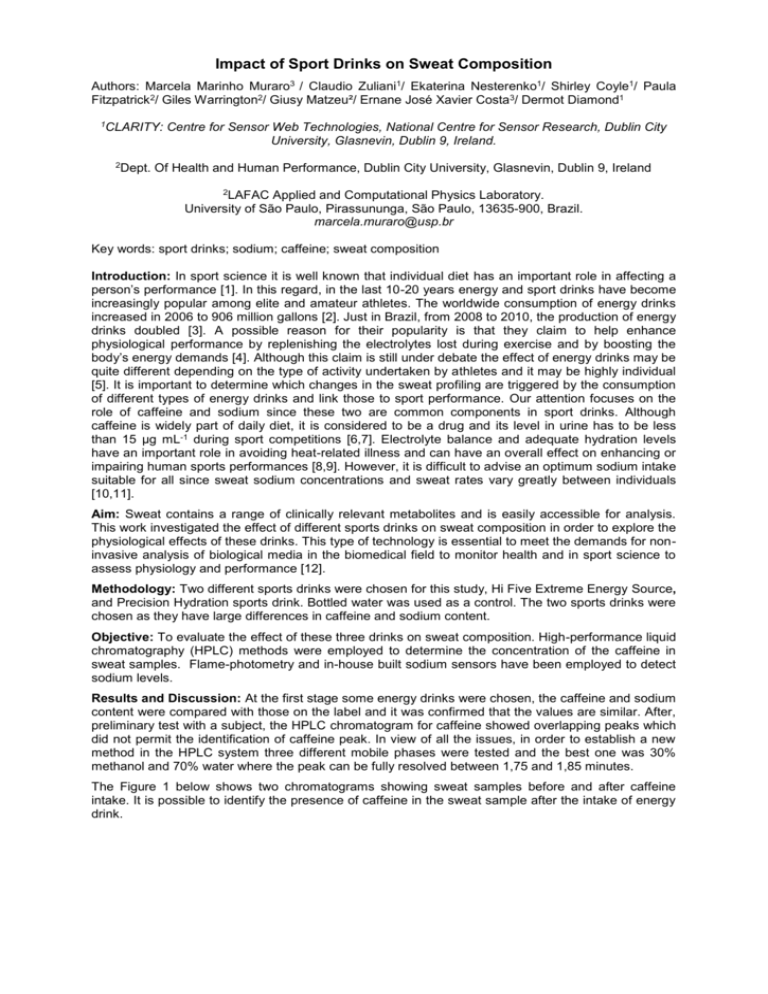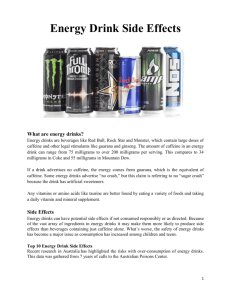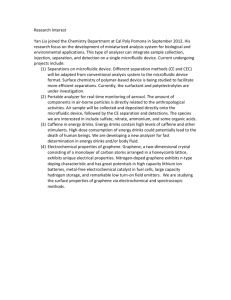Microsoft Word
advertisement

Impact of Sport Drinks on Sweat Composition Authors: Marcela Marinho Muraro3 / Claudio Zuliani1/ Ekaterina Nesterenko1/ Shirley Coyle1/ Paula Fitzpatrick2/ Giles Warrington2/ Giusy Matzeu²/ Ernane José Xavier Costa3/ Dermot Diamond1 1CLARITY: 2Dept. Centre for Sensor Web Technologies, National Centre for Sensor Research, Dublin City University, Glasnevin, Dublin 9, Ireland. Of Health and Human Performance, Dublin City University, Glasnevin, Dublin 9, Ireland 2LAFAC Applied and Computational Physics Laboratory. University of São Paulo, Pirassununga, São Paulo, 13635-900, Brazil. marcela.muraro@usp.br Key words: sport drinks; sodium; caffeine; sweat composition Introduction: In sport science it is well known that individual diet has an important role in affecting a person’s performance [1]. In this regard, in the last 10-20 years energy and sport drinks have become increasingly popular among elite and amateur athletes. The worldwide consumption of energy drinks increased in 2006 to 906 million gallons [2]. Just in Brazil, from 2008 to 2010, the production of energy drinks doubled [3]. A possible reason for their popularity is that they claim to help enhance physiological performance by replenishing the electrolytes lost during exercise and by boosting the body’s energy demands [4]. Although this claim is still under debate the effect of energy drinks may be quite different depending on the type of activity undertaken by athletes and it may be highly individual [5]. It is important to determine which changes in the sweat profiling are triggered by the consumption of different types of energy drinks and link those to sport performance. Our attention focuses on the role of caffeine and sodium since these two are common components in sport drinks. Although caffeine is widely part of daily diet, it is considered to be a drug and its level in urine has to be less than 15 µg mL-1 during sport competitions [6,7]. Electrolyte balance and adequate hydration levels have an important role in avoiding heat-related illness and can have an overall effect on enhancing or impairing human sports performances [8,9]. However, it is difficult to advise an optimum sodium intake suitable for all since sweat sodium concentrations and sweat rates vary greatly between individuals [10,11]. Aim: Sweat contains a range of clinically relevant metabolites and is easily accessible for analysis. This work investigated the effect of different sports drinks on sweat composition in order to explore the physiological effects of these drinks. This type of technology is essential to meet the demands for noninvasive analysis of biological media in the biomedical field to monitor health and in sport science to assess physiology and performance [12]. Methodology: Two different sports drinks were chosen for this study, Hi Five Extreme Energy Source, and Precision Hydration sports drink. Bottled water was used as a control. The two sports drinks were chosen as they have large differences in caffeine and sodium content. Objective: To evaluate the effect of these three drinks on sweat composition. High-performance liquid chromatography (HPLC) methods were employed to determine the concentration of the caffeine in sweat samples. Flame-photometry and in-house built sodium sensors have been employed to detect sodium levels. Results and Discussion: At the first stage some energy drinks were chosen, the caffeine and sodium content were compared with those on the label and it was confirmed that the values are similar. After, preliminary test with a subject, the HPLC chromatogram for caffeine showed overlapping peaks which did not permit the identification of caffeine peak. In view of all the issues, in order to establish a new method in the HPLC system three different mobile phases were tested and the best one was 30% methanol and 70% water where the peak can be fully resolved between 1,75 and 1,85 minutes. The Figure 1 below shows two chromatograms showing sweat samples before and after caffeine intake. It is possible to identify the presence of caffeine in the sweat sample after the intake of energy drink. Intensity /mAU 50 Before Caffeine intake After Caffeine intake 40 30 20 Caffeine 10 0 0 0.5 1 1.5 2 Time / Min Figure 1: Chromatograms before and after caffeine intake. Conclusions: In this study we have shown the individual effects of sports drinks on sweat composition. The intake of energy drinks that contain caffeine has an interesting impact on the sweat composition. The intake of energy drinks with high level of sodium had a slight impact on the sweat concentration. This is based on preliminary results. We are currently carrying out trials on more subjects. An individualized approach to hydration drink composition would be highly advantageous and this requires individual testing. The development of wearable sensors would be of great use for this purpose. The measurements from this work are also really important to identify suitable sensor targets for future wearable sensors development. Such sensors may provide real time feedback to help enhance athlete’s performance and maintain health. We would prefer to present this work as a poster in the event that the paper is selected. References: [1] Lancha Junior, A.H. 2011. Nutrition applied to motor activity. Revista Brasileira De Educação Física e Esporte, 25(SPE), pp.45-51.[2] Reissig, C.J., Strain, E.C. and Griffiths, R.R. 2009. Caffeinated energy drinks—a growing problem. Drug and Alcohol Dependence, 99(1), pp.1-10. [3] ABIR – Associação Brasileira das Indústrias de Refrigerantes e de Bebidas Não Alcoólicas [Online]. Available from: http://abir.org.br/2011/10/24/dados-de-mercado-2011/ [Accessed 11 June 2013]. [4] Aranda, M. and Morlock, G. 2006. Simultaneous determination of riboflavin, pyridoxine, nicotinamide, caffeine and taurine in energy drinks by planar chromatography-multiple detection with confirmation by electrospray ionization mass spectrometry. Journal of Chromatography A, 1131(1), pp.253-260. [5] McCormack, W.P. and Hoffman, J.R. 2012. Caffeine, Energy Drinks, and Strength-Power Performance. Strength & Conditioning Journal, 34(4), pp.11-16. [6] FDA (Food Drug Administration) 2007.Medicines in my Home: Caffeine and Your Body [Online]. Available from: http://www.fda.gov/downloads/Drugs/ResourcesForYou/Consumers/BuyingUsingMedicineSafely/Unde rstandingOver-the-CounterMedicines/UCM205286.pdf. [Acessed 16 April 2013]. [7] WADA 2012 [Online] Available from: http://www.wada-ama.org/en/Resources/Q-and-A/2012ProhibitedList/ and http://www.wada-ama.org/Documents/World_Anti-Doping_Program/WADP-Prohibitedlist/2013/WADA-Monitoring-Program-2013-EN.pdf [Accessed 17April 2013]. [8] Valentine, V. 2007. The importance of salt in the athlete’s diet. Current Sports Medicine Reports, 6(4), pp.237-240. [9] R. J. Maughan, "Impact of mild dehydration on wellness and on exercise performance," European Journal of Clinical Nutrition vol. 57, pp. S19-S23, 2003. [10] R. J. Maughan and S. M. Shirreffs, "Development of individual hydration strategies for athletes," International Journal of Sport Nutrition and Exercise Metabolism, vol. 18, pp. 457-72, 2008. [11] Australian Institute of Sport (AIS) 2011. Electrolyte replacement supplements [Online]. Available from: http://www.ausport.gov.au/__data/assets/pdf_file/0011/463538/Electrolyte_replacement_11_website_fact_sheet.pdf [Accessed 17 April 2013]. [12] Tsuda, T., Noda, S., Kitagawa, S. and Morishita, T. 2000. Proposal of sampling process for collecting human sweat and determination of caffeine concentration in it by using GC/MS. Biomedical Chromatography, 14(8), pp.505-510.




